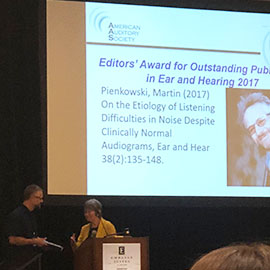 Dr. Martin Pienkowski, associate professor in the University’s Osborne College of Audiology, is this year’s winner for the Ear and Hearing Editor’s award, which was recently presented at the 2018 American Auditory Society (AAS) meeting in Scottsdale, Ariz.
Dr. Martin Pienkowski, associate professor in the University’s Osborne College of Audiology, is this year’s winner for the Ear and Hearing Editor’s award, which was recently presented at the 2018 American Auditory Society (AAS) meeting in Scottsdale, Ariz.
The goal of the American Auditory Society (AAS) is to increase knowledge and understanding of the ear, hearing and balance in addition to disorders of the ear, hearing and balance, and prevention of these disorders. The nature of the society is multi-disciplinary, spanning across fields such as audiology, otolaryngology, dispensing, engineering, psychoacoustics, etc. to provide a formal platform for all of its members and students to exchange information.
Dr. Pienkowski explained the fundamental challenges of hidden hearing loss and the opportunities clinicians have to tailor to patients with hearing losses that are not detectible with current testing paradigms. Hidden hearing loss is a type of hearing loss that cannot be measured by the most common hearing test, an audiogram, which measures up to 8000Hz. This is because, hidden hearing loss doesn’t normally affect a person’s ability to hear quiet sounds, but it makes it harder to hear sounds when there is competing background noise. Hidden hearing loss is often misdiagnosed or failed to be diagnosed for a long time.
According to Dr. Pienkowski, his article, On the Etiology of Listening Difficulties in Noise Despite Clinically Normal Audiograms, “attempted to synthesize all potential contributors to speech in noise problems, and provided suggestions on how to clinically differentiate between them, with the ultimate goal of better tailoring treatments such as computer-based perceptual training to the deficits of individual patients.”
The primary focus of the article was to discuss why people with seemingly “normal” audiometric results might have so much difficulty following conversations in noisy environments. According to Dr. Pienkowski, these people may be suffering from either “hidden hearing loss” in the high frequency region of the cochlea (inner ear) or impairment of the central auditory processing pathway. The article suggests that new protocols in hearing testing, including high frequency audiometry, psychoacoustic measures, and electrophysiologic methods may be more effective in capturing these types of “hidden” losses, or accurate in defining certain impairments in central auditory processing.
“The award is good motivation to continue my research and writing efforts,” Dr. Pienkowski said.